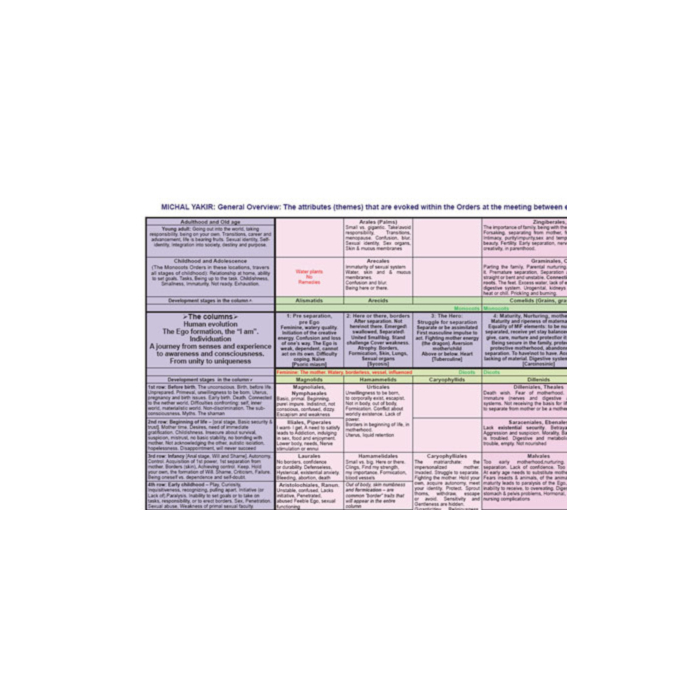Table of Plants
Share on social media
The book "Table of Plants - Wondrous Order" has been released in English. As an introduction, his short table is available. The table summarises the concepts of the book, giving the main qualities of each family and order of plants according to its position in the table.
Similarly like the periodic table, the botanical system can be used as a basis for homeopathic prescribing. The homeopath Michal Yakir, a former botanist, uses the Cronquist system and has developped a logical and easy to use way of applying the plant system to homeopathy. The table provides a scheme that connects between plant development stages to human developmental stages – from birth to old age: from unity to individuality.
The plant table explains the traits of groups of plants, small remedies and new provings. Even our cases can be understood more clearly, and the homeopathic prescription improved.
The columns (botanical sub-classes) portray a journey of differentiation and independence from the state of oneness, from the wholeness of “self”, toward formation of an individual ego: from unity to separation, first from the feminine element, later on from masculine element, receiving the teaching and issues of each. Contenting with those elements allows departure from the ego closure and advancement toward relationship with “the other” and interaction and contact with the outer world: From union and oneness to a differentiated ego, able to cooperate as individual with the collective.
The rows (the orders, the botanical groups within each column) describe stages of development and maturation in each column, starting with pre-birth, through infancy, childhood and adolescence until maturity and old age.
The grouping of rows and columns: Every phase of ego separation from the self is experienced within the column in different levels of development, and is expressed accordingly.
Dr Mahesh Gandhi wrote about Michal Yakir:
"I have had an opportunity to learn from Michal Yakir her novel understanding of plants from development point of view. It makes a lot of sense to me and has changed my outlook towards plants. I am using her ideas in my practise with excellent results. She has made the plant kingdom very understandable by her simple yet deep understanding of them based on the concept of evolution of plants. It is indeed a very fascinating and a practical work. It gives an additional dimension to our understanding of known plants and also helps us prescribe some yet unknown plants with confidence. It is a very extensive work which can help us prescribe more efficiently in our daily homoeopathic practise. It compliments all that we know about plants from other teachers like Sankaran and Scholten. I would recommend every serious homoeopath to learn it as it will prove to be a useful tool in helping us help our patients."
| ISBN | 9783955820046 |
|---|---|
| Author | Michal Yakir |
| Type | Pamphlet |
| Language | English |
| Publication Date | 2013 |
| Pages | 11 |
| Publisher | Narayana Verlag |

